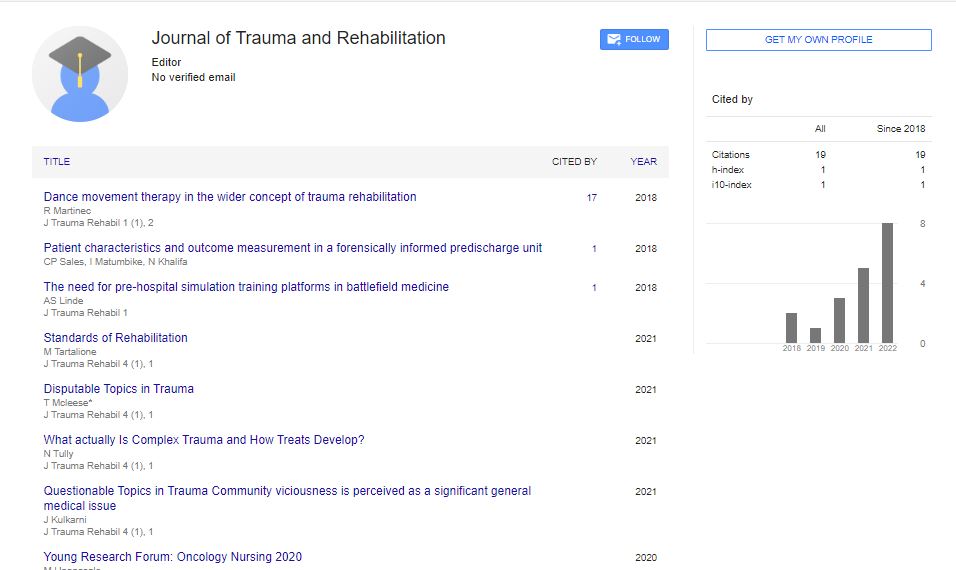Opinion Article, J Trauma Rehabil Vol: 6 Issue: 2
Revolutionizing Rehabilitation: Advancements, Personalization, and Empowerment for Recovery
Rafael Gomez*
1Department of Trauma Surgery, University Hospital, Berlin, Germany
*Corresponding Author: Rafael Gomez,
Department of Trauma Surgery,
University Hospital, Berlin, Germany
E-mail: rafael.gomez@gmail.com
Received date: 29 May, 2023, Manuscript No. JTR-23-106890;
Editor assigned date: 31 May, 2023, PreQC No. JTR-23-106890 (PQ);
Reviewed date: 14 June, 2023, QC No. JTR-23-106890;
Revised date: 21 June, 2023, Manuscript No. JTR-23-106890 (R);
Published date: 28 June, 2023, DOI: 10.4172/Jtr.1000128
Citation: Gomez R (2023) Revolutionizing Rehabilitation: Advancements, Personalization, and Empowerment for Recovery. J Trauma Rehabil 6:2.
Description
Rehabilitation is a vital aspect of healthcare that aims to restore and improve an individual's physical, cognitive, and emotional functionality after an injury, illness, or medical condition. Over the years, advancements in medical science and technology have led to the development of modern techniques that are revolutionizing the field of rehabilitation. These innovative approaches, grounded in evidence-based practices, are transforming the way patients recover and regain functionality.
Targeted and individualized interventions
Modern rehabilitation techniques prioritize personalized care, tailoring interventions to each patient's unique needs and goals. Advanced assessment tools and technologies enable healthcare professionals to gain a comprehensive understanding of the patient's condition, capabilities, and challenges. This individualized approach ensures that the rehabilitation plan is focused on the specific areas that require improvement, optimizing the recovery process.
Advanced assessment technologies: State-of-the-art tools such as motion analysis systems, 3D imaging, and wearable sensors provide detailed data on patients' movement patterns, strength, and joint function.
Personalized treatment plans: Utilizing the data obtained from assessments, rehabilitation specialists design customized treatment plans that address the patient's specific impairments and functional goals.
Patient-centered care: By involving patients in their treatment decision-making and setting achievable milestones, modern rehabilitation techniques empower individuals to take an active role in their recovery.
Technological Innovations in Rehabilitation
Technological advancements have significantly impacted rehabilitation, offering novel tools and methods to enhance functionality and recovery. These technologies are revolutionizing traditional rehabilitation practices and introducing new possibilities for patient care.
Virtual Reality (VR) and Augmented Reality (AR): VR and AR technologies develops immersive environments for therapeutic activities, enabling patients to practice real-life scenarios, enhance motor skills, and regain confidence.
Tele-rehabilitation: Telehealth and tele-rehabilitation platforms extend access to rehabilitation services, connecting patients with therapists remotely for ongoing monitoring and support.
Harnessing neuroplasticity for recovery
The understanding of neuroplasticity, the brain's ability to adapt and reorganize in response to experiences, has transformed rehabilitation approaches. Modern techniques leverage neuroplasticity to optimize recovery and promote functional improvements.
Task-specific training: Rehabilitation exercises are designed to mimic real-life activities, stimulating specific neural pathways and fostering functional recovery.
Constraint-Induced Movement Therapy (CIMT): CIMT involves restricting the use of the unaffected limb, forcing the patient to use the affected limb, encouraging neuroplastic changes and motor improvement.
Repetitive Transcranial Magnetic Stimulation (RTMS): RTMS is a non-invasive brain stimulation technique that can enhance neuroplasticity and support recovery in certain neurological conditions.
Integrating interdisciplinary approaches
Modern rehabilitation techniques embrace a collaborative and interdisciplinary approach to patient care. By bringing together experts from various healthcare fields, rehabilitation teams can address the complex and multifaceted needs of patients more effectively.
Collaborative care: Rehabilitation teams comprise physiotherapists, occupational therapists, speech therapists, psychologists, and other specialists, fostering a holistic and comprehensive approach to patient care.
Team-based decision making: Interdisciplinary teams work together to design integrated treatment plans, ensuring that various aspects of the patient's rehabilitation are considered.
Team-based decision making: Interdisciplinary teams work together to design integrated treatment plans, ensuring that various aspects of the patient's rehabilitation are considered.
Communication and coordination: Regular team meetings and effective communication facilitate seamless coordination of care, optimizing the patient's rehabilitation journey.
Empowering patients through education
Modern rehabilitation techniques place significant emphasis on patient education and empowerment. Providing patients with the knowledge and tools to actively participate in their recovery process can lead to better outcomes and long-term functional gains.
Education on self-management: Patients are educated on managing their conditions, recognizing warning signs, and implementing strategies to prevent setbacks.
Lifestyle and wellness education: Rehabilitation professionals offer guidance on maintaining a healthy lifestyle, including nutrition, exercise, and stress management, to support overall well-being.
Transition planning: Patients and their families receive education on transitioning back to daily life and work, ensuring a smooth continuation of rehabilitation efforts.
Conclusion
Utilizing modern techniques to revolutionize rehabilitation has transformed the landscape of patient care. Advanced technologies, personalized interventions, and interdisciplinary collaboration are enhancing functionality and quality of life for individuals undergoing rehabilitation. By harnessing the potential of neuroplasticity, adopting innovative technologies, and empowering patients through education, rehabilitation professionals are achieving remarkable outcomes. The integration of modern rehabilitation techniques into clinical practice offers new possibilities for recovery and functional improvements, inspiring hope for patients and healthcare providers alike. As the field of rehabilitation continues to evolve, these advancements will shape a more inclusive and effective rehabilitation journey for individuals worldwide.
 Spanish
Spanish  Chinese
Chinese  Russian
Russian  German
German  French
French  Japanese
Japanese  Portuguese
Portuguese  Hindi
Hindi 